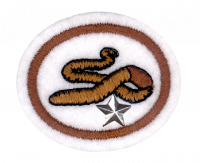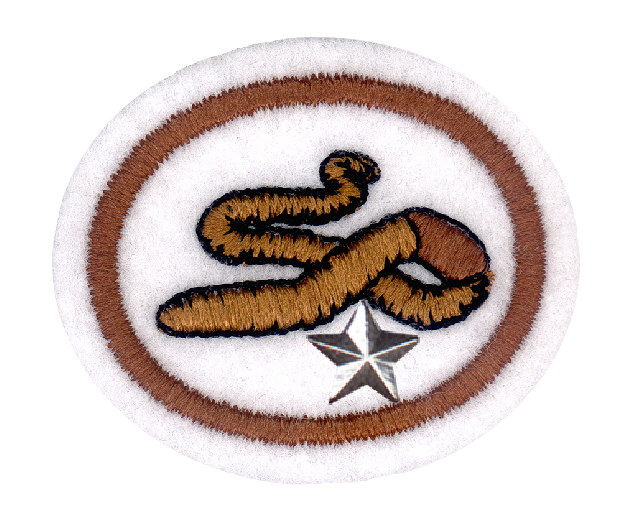Difference between revisions of "AY Honors/Worms - Advanced/Answer Key/es"
From Pathfinder Wiki
< AY Honors | Worms - AdvancedAY Honors/Worms - Advanced/Answer Key/es
(Created page with "</noinclude> <!-- 2. Nombrar un ejemplo de un nematodo y describir su ciclo de vida. -->") |
(Updating to match new version of source page) |
||
| (7 intermediate revisions by 2 users not shown) | |||
| Line 1: | Line 1: | ||
{{HonorSubpage}} | {{HonorSubpage}} | ||
| − | <section begin="Body" /> | + | |
| + | <section begin="Body" /> | ||
| + | |||
{{ansreq|page={{#titleparts:{{PAGENAME}}|2|1}}|num=1}} | {{ansreq|page={{#titleparts:{{PAGENAME}}|2|1}}|num=1}} | ||
<noinclude></noinclude> | <noinclude></noinclude> | ||
| − | <!-- 1. ¿Cuáles son las tres clases principales de los platelmintos y describirlos. --> | + | <!-- 1. Tener la especialidad de Lombrices. --> |
| + | {{honor_prerequisite|displayname=Lombrices|honor=Worms}} | ||
| + | |||
| + | <noinclude></noinclude> | ||
| + | {{CloseReq}} <!-- 1 --> | ||
| + | {{ansreq|page={{#titleparts:{{PAGENAME}}|2|1}}|num=2}} | ||
| + | <noinclude></noinclude> | ||
| + | <!-- 2. ¿Cuáles son las tres clases principales de los platelmintos y describirlos. --> | ||
{{clear}} | {{clear}} | ||
| Line 13: | Line 22: | ||
{{clear}} | {{clear}} | ||
| − | + | ||
<noinclude></noinclude> | <noinclude></noinclude> | ||
| − | {{CloseReq}} <!-- | + | {{CloseReq}} <!-- 2 --> |
| − | {{ansreq|page={{#titleparts:{{PAGENAME}}|2|1}}|num= | + | {{ansreq|page={{#titleparts:{{PAGENAME}}|2|1}}|num=3}} |
<noinclude></noinclude> | <noinclude></noinclude> | ||
| − | <!-- | + | <!-- 3. Nombrar un ejemplo de un nematodo y describir su ciclo de vida. --> |
{{clear}} | {{clear}} | ||
| Line 36: | Line 45: | ||
{{clear}} | {{clear}} | ||
| − | {{clear}} | + | {{clear}} |
| + | |||
<noinclude></noinclude> | <noinclude></noinclude> | ||
| − | {{CloseReq}} <!-- | + | {{CloseReq}} <!-- 3 --> |
| − | {{ansreq|page={{#titleparts:{{PAGENAME}}|2|1}}|num= | + | {{ansreq|page={{#titleparts:{{PAGENAME}}|2|1}}|num=4}} |
<noinclude></noinclude> | <noinclude></noinclude> | ||
| − | <!-- | + | <!-- 4. ¿Cuáles son las tres clases principales de los anélidos y cómo se mueven? --> |
{{clear}} | {{clear}} | ||
| Line 51: | Line 61: | ||
<noinclude></noinclude> | <noinclude></noinclude> | ||
| − | {{CloseReq}} <!-- | + | {{CloseReq}} <!-- 4 --> |
| − | {{ansreq|page={{#titleparts:{{PAGENAME}}|2|1}}|num= | + | {{ansreq|page={{#titleparts:{{PAGENAME}}|2|1}}|num=5}} |
<noinclude></noinclude> | <noinclude></noinclude> | ||
| − | <!-- | + | <!-- 5. Responder las siguientes: --> |
<noinclude></noinclude> | <noinclude></noinclude> | ||
| − | {{ansreq|page={{#titleparts:{{PAGENAME}}|2|1}}|num= | + | {{ansreq|page={{#titleparts:{{PAGENAME}}|2|1}}|num=5a}} |
<noinclude></noinclude> | <noinclude></noinclude> | ||
| − | + | {{clear}} | |
| − | |||
| − | |||
| − | + | {{clear}} | |
| − | |||
| − | |||
| − | |||
| − | |||
| − | |||
| − | |||
| − | |||
| − | |||
| − | |||
| − | |||
| − | |||
| − | |||
| − | |||
| − | < | + | <noinclude></noinclude> |
| − | + | {{CloseReq}} <!-- 5a --> | |
| − | </ | + | {{ansreq|page={{#titleparts:{{PAGENAME}}|2|1}}|num=5b}} <!--T:25--> |
| + | <noinclude></noinclude> | ||
| − | + | {{clear}} | |
| − | |||
| − | |||
| − | + | {{clear}} | |
| − | |||
| − | |||
| − | + | {{clear}} | |
| − | |||
| − | |||
| − | {{ | ||
| − | |||
| − | |||
| − | |||
| − | |||
| − | |||
| − | |||
| − | < | + | <noinclude></noinclude> |
| − | + | {{CloseReq}} <!-- 5b --> | |
| − | </ | + | {{CloseReq}} <!-- 5 --> |
| + | {{ansreq|page={{#titleparts:{{PAGENAME}}|2|1}}|num=6}} | ||
| + | <noinclude></noinclude> | ||
| + | <!-- 6. Ser capaz de demostrar tres formas de purificar el agua. --> | ||
| − | + | {{clear}} | |
| − | |||
| − | |||
| − | + | {{clear}} | |
| − | |||
| − | |||
| − | + | {{clear}} | |
| − | |||
| − | |||
| − | + | {{clear}} | |
| − | |||
| − | |||
| − | + | {{clear}} | |
| − | |||
| − | |||
| − | + | {{clear}} | |
| − | <noinclude | + | |
| − | + | <noinclude></noinclude> | |
| − | {{CloseReq}} <!-- | + | {{CloseReq}} <!-- 6 --> |
| − | {{ansreq|page={{#titleparts:{{PAGENAME}}|2|1}}|num= | + | {{ansreq|page={{#titleparts:{{PAGENAME}}|2|1}}|num=7}} |
| − | <noinclude> | + | <noinclude></noinclude> |
| − | </noinclude> | + | <!-- 7. Completar lo siguiente: --> |
| − | <!-- | ||
| − | |||
| − | |||
| − | + | <noinclude></noinclude> | |
| − | <noinclude | + | {{ansreq|page={{#titleparts:{{PAGENAME}}|2|1}}|num=7a}} <!--T:37--> |
| − | + | <noinclude></noinclude> | |
| − | {{ansreq|page={{#titleparts:{{PAGENAME}}|2|1}}|num= | ||
| − | <noinclude> | ||
| − | </noinclude | ||
| − | |||
| − | + | {{clear}} | |
| − | |||
| − | |||
| − | + | <noinclude></noinclude> | |
| − | <noinclude | + | {{CloseReq}} <!-- 7a --> |
| − | + | {{ansreq|page={{#titleparts:{{PAGENAME}}|2|1}}|num=7b}} <!--T:39--> | |
| − | {{CloseReq}} <!-- | + | <noinclude></noinclude> |
| − | {{ansreq|page={{#titleparts:{{PAGENAME}}|2|1}}|num= | ||
| − | <noinclude> | ||
| − | </noinclude | ||
| − | |||
| − | |||
| − | |||
| − | |||
| − | |||
| − | |||
| − | |||
| − | |||
| − | |||
| − | |||
| − | |||
| − | |||
| − | |||
| − | < | + | <noinclude></noinclude> |
| − | <noinclude> | + | {{CloseReq}} <!-- 7b --> |
| − | < | ||
{{CloseReq}} <!-- 7 --> | {{CloseReq}} <!-- 7 --> | ||
| − | <noinclude> | + | {{ansreq|page={{#titleparts:{{PAGENAME}}|2|1}}|num=8}} |
| − | </noinclude> | + | <noinclude></noinclude> |
| − | + | <!-- 8. Describir una lección espiritual sobre el agua viva de la Biblia. --> | |
| − | + | ||
| − | + | <noinclude></noinclude> | |
| − | + | {{CloseReq}} <!-- 8 --> | |
| − | + | <noinclude></noinclude></noinclude> | |
| − | |||
| − | |||
| − | </ | ||
| − | + | [[Category:Adventist Youth Honors Answer Book/Do at home{{GetLangSuffix}}]] | |
| − | |||
| − | [[Category:Adventist Youth Honors Answer Book/Do at home | ||
| − | |||
| − | |||
{{CloseHonorPage}} | {{CloseHonorPage}} | ||
Latest revision as of 15:50, 3 January 2023
Lombrices- Avanzado
Nivel de destreza
2
Año
2006
Version
07.11.2025
Autoridad de aprobación
Asociación General
1
Tener la especialidad de Lombrices.
Para consejos e instrucciones, véase Lombrices.
2
¿Cuáles son las tres clases principales de los platelmintos y describirlos.
3
Nombrar un ejemplo de un nematodo y describir su ciclo de vida.
4
¿Cuáles son las tres clases principales de los anélidos y cómo se mueven?
5
Responder las siguientes:
5a
Distinguir entre las siguientes estructuras corporales: celomados, pseudocelomados y acelomados.
5b
Qué estructuras corporales son comunes en los tres filos de lombrices?
6
Ser capaz de demostrar tres formas de purificar el agua.
7
Completar lo siguiente:
7a
De los que ha aprendido acerca de las lombrices, ¿por qué es tan importante la disponibilidad de agua limpia para la salud humana, especialmente en los países del tercer mundo?
7b
Organizar la recaudación de fondos para apoyar las organizaciones que se esfuerzan por proporcionar agua limpia a países del tercer mundo.
8
Describir una lección espiritual sobre el agua viva de la Biblia.


